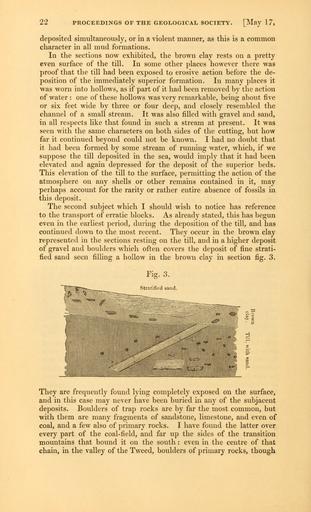MAKE A MEME
View Large Image

| View Original: | The_Quarterly_journal_of_the_Geological_Society_of_London_(12645079763).jpg (1210x1992) | |||
| Download: | Original | Medium | Small | Thumb |
| Courtesy of: | commons.wikimedia.org | More Like This | ||
| Keywords: The Quarterly journal of the Geological Society of London (12645079763).jpg 22 <br> PROCEEDINGS OF THE GEOLOGICAL SOCIETY MaV 17 <br> deposited simultaneously or in a violent manner as this is a common <br> character in all mud formations <br> In the sections now exhibited the brown clay rests on a pretty <br> even surface of the till In some other places however there was <br> proof that the till had been exposed to erosive action before the de- <br> position of the immediately superior formation In many places it <br> was worn into hollows as if part of it had been removed by the action <br> of water one of these hollows was very remarkable being about five <br> or six feet wide by three or four deep and closely resembled the <br> channel of a small stream It was also filled with gravel and sand <br> in all respects like that found in such a stream at present It was <br> seen with the same characters on both sides of the cutting but how <br> far it continued beyond could not be known I had no doubt that <br> it had been formed by some stream of rummig water which if we <br> suppose the till deposited in the sea would imply that it had been <br> elevated and again depressed for the deposit of the superior beds <br> This elevation of the till to the surface permitting the action of the <br> atmosphere on any shells or other remains contained in it may <br> perhaps accomit for the rarity or rather entire absence of fossils in <br> this deposit <br> The second subject which I should wish to notice has reference <br> to the transport of erratic blocks As already stated this has begun <br> even in the earliest period during the deposition of the till and has <br> continued down to the most recent They occur in the brovra clay <br> represented in the sections resting on the till and in a higher deposit <br> of gravel and boulders which often covers the deposit of fine strati- <br> fied sand seen filling a hollow in the brownii clay in section fig 3 <br> Fig 3 <br> Stratified sand <br> They are frequently found lying completely exposed on the surface <br> and in this case may never have been buried in any of the subjacent <br> deposits Boulders of trap rocks are by far the most common but <br> with them are many fragments of sandstone limestone and even of <br> coal and a few also of primary rocks I have found the latter over <br> every part of the coal-field and far up the sides of the transition <br> mountains that bound it on the south even in the centre of that <br> chain in the valley of the Tweed boulders of primary rocks though 35268656 109512 51125 Page 22 Text v 5 http //www biodiversitylibrary org/page/35268656 1849 Geological Society of London Biodiversity Heritage Library The Quarterly journal of the Geological Society of London v 5 1849 Geology Periodicals Smithsonian Libraries bhl page 35268656 dc identifier http //biodiversitylibrary org/page/35268656 smithsonian libraries Information field Flickr posted date ISOdate 2014-02-20 Check categories 2015 August 26 CC-BY-2 0 BioDivLibrary https //flickr com/photos/61021753 N02/12645079763 2015-08-27 10 52 34 cc-by-2 0 PD-old-70-1923 The Quarterly journal of the Geological Society of London 1849 Photos uploaded from Flickr by Fæ using a script | ||||